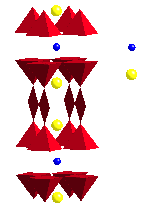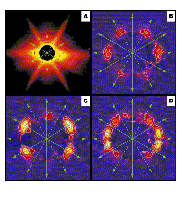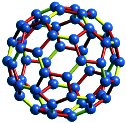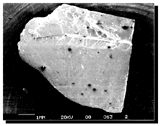Superconductivity
A Brief History of Superconductivity
| The phenomenon of superconductivity was first observed by Kamerlingh Onnes in Leiden in 1911[1] . In the superconducting state the dc electrical resistivity is zero. | 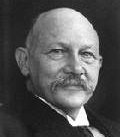 |
| Heike Kamerlingh Onnes, was awarded the 1913 Nobel Prize in Physics for his discovery of superconductivity. |
. 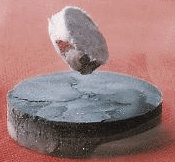 |
The magnetic properties exhibited by superconductors are just as dramatic. If a type I superconductor is placed in a magnetic field below a critical value Hc, then cooled through its superconducting transition temperature, (Tc), the magnetic flux originally present in the sample is ejected from the specimen. This is called the Meissner effect [2]. |
| A magnet floating above a disc of ceramic superconductor due to a combination of flux pinning and flux expulsion. |
| If a type II superconductor is cooled below Tc in a magnetic field less than its lower critical field, (H<Hc1), it will also enter the Meissner state. For fields above the lower critical field Hc1 but below an upper critical field Hc2, (Hc1<H<Hc2), type II superconductors enter a mixed state in which the material is threaded by an array of lines of magnetic flux forming an Abrikosov or flux line lattice [3]. | 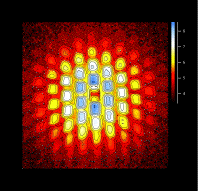 |
| The hexagonal arrangement of magnetic flux lines in pure Nb imaged using neutrons |
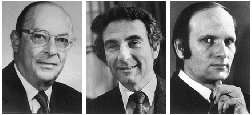 |
The superconducting state results from an ordering of the conduction electrons into Cooper pairs via an electron-phonon exchange coupling. The nature and origin of this ordering was explained by Bardeen, Cooper, and Schrieffer (BCS). All elemental and most alloy superconductors are s-wave BCS superconductors [4]. |
| John Bardeen, Leon Cooper, and J. Robert Schrieffer, 1972 Nobel laureates for their BCS theory of superconductivity. |
| Under suitable conditions remarkable macroscopic quantum mechanical effects associated with the tunnelling of the superconducting electron pairs are observed. These include the ac and dc Josephson effects [5]. SQUIDs (superconducting quantum interference device) are now used in applications. | 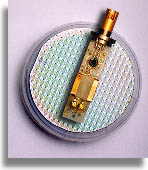 |
| A Quantum Design thin film SQUID sensor. |
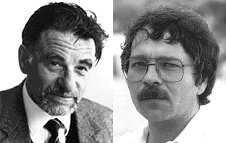 |
Y Ba |
|
| K. Alex Muller and J. Georg Bednorz from IBM Zurich discovered ceramic high temperature superconductors. They won the 1987 Nobel Prize in Physics. |
YBa2Cu3O7-d, a cuprate superconductor with a Tc of 92 K. Note the Cu-O octahedra and chains are shown in red. |
The discovery by Bednorz and Müller of high temperature superconductivity in the cuprates [6] along with the observation of superconductivity in heavy fermions [7], the doped carbon fullerenes and some organic materials has led to a resurgence of interest in superconductivity [8-9].
|
|
|
|
SANS data showing the change in the morphology of the flux line lattice in the heavy fermion superconductor UPt3 [7]. |
There are many fullerence superconductors including Cs3C60 that has a Tc of 40 K. |
Experimental evidence for exotic p and d wave superconductivity has recently been presented [10]. A number of new materials that show a coexistence of magnetism and superconductivity have also been discovered [11]. These materials allow us to investigate the interplay between two phenomena that are usually mutually exclusive. A whole range of subtle and fascinating new behaviours have been observed in the mixed state of superconductors including flux creep, thermally activated flux flow, flux pancakes, fll melting, reversible and irreversible behaviour, the peak effect and the generalised Fulde-Ferrel-Larkin-Ovchinnokov state to name but a few!
Superconductivity at Warwick
Since the Group was established in 1985, we have made a number of important contributions to the understanding of the physics of superconducting materials. Other Groups here at Warwick including Theory and the NMR have also worked extensively on superconducting materials.
We began working on high temperature superconductors shortly after their discovery in 1986. We studied the unusual vibrational and structural behaviour of the compound La1.85 Ba0.15CuO4 [12] and investigated the nature of the magnetic ordering in the rare earth-Ba2Cu3O7 series of compounds [13].
In 1990 we began using neutron scattering to study the mixed state of the high temperature superconductors. The neutrons are diffracted by the ordered periodic distribution of the magnetic flux within the sample with contrast being provided by the variation in the magnetic induction. These diffraction experiments must be performed on a small angle diffraction instrument, since the typical lattice spacing in the available range of magnetic field with the optimum neutron wavelength leads to scattering angles of < 0.5 degree. We examined the vortex lattice structure in YBa2Cu3O7 [14] and were the first to directly observe the melting and decomposition of the magnetic-flux lattice in the high-Tc superconductor Bi2.15Sr1.95CaCu2O8+x [15].
|
|
We also began our successful crystal growth programme using an infra red image furnace as well as more conventional flux and vapour transport growth methods to produce high quality samples of many types of superconductors [16]. |
| A single crystal of Bi2Sr2CaCu2O8 grown in the IR image furnace at Warwick. |
| In 1994 we began work on a new class of superconductors with the general chemical formula RNi2B2C. The layered structure of these materials means that for some of this series there is a co-existence of long range magnetic order with superconductivity at the same temperature. This is very rare and provides us with an exciting opportunity to study the interplay between these two phenomena. |
Superconducting and magnetic H-T phase diagram of HoNi2B2C (see ref. 18 for more details). |
The borocarbides have been shown to exhibit a rich variety of magnetic and superconducting properties [17]. We have used neutron scattering, magnetometry and local Hall probes to probe the complex behaviour of the normal and superconducting states of these materials [18].
| Our studies of the flux-line lattice (fll) in various superconductors have been a marked success and created considerable international interest. We refined our neutron scattering techniques and greatly enhanced the resolution with which it is possible to make such measurements. This allowed us to perform a series of very high resolution experiments examining the role of "non-local" effects in determining the distortion of the fll and permitted a completely new slant on the problem of the coexistence of magnetism and superconductivity to be developed. | |
| An image of the flux-line lattice in the magnetic superconductor TmNi2B2C. |
These measurements have been complemented by the "global" magnetisation and resistivity studies undertaken in our laboratories. Data was also collected through a collaboration with a group in Cambridge, using a miniature Hall detector array to study the "local" magnetisation across single crystal samples. Our studies on HoNi2B2C demonstrated the power of this technique for understanding the role of the magnetic modulations on pinning the flux distributions.
Cuurrent Research at Warwick
Our current interests are centred on the role of various mechanisms in determining the morphology, distortion and the role of pinning on the properties of the fll in a range of superconductors. Particular emphasis has been, and will continue to be, given to the role of Fermi surface distortion and magnetism on such features. The primary materials of interest in such investigations are the noncentrosymmetric (NCS) superconductors, two-band superconductors, and heavy fermion superconductors and magnets.
We have shown that in CaAlSi [19], the reorientation of the FLL is due to non-local rather than multi-band effects, and examined the two-gap behaviour in Lu2Fe3Si5 [20].

| SANS diffraction patterns of CaAlSi taken at 2 K in applied magnetic fields of 97, 185, 250, and 294 Oe respectively. (e) Schematic diagram of the FLL patterns in real-space (upper panel) and the corresponding diffraction patterns (lower panel). |
We have worked on a number of superconductors with a NCS structure. In noncentrosymmetric structures, i.e. systems without inversion symmetry, parity is no longer a meaningful label. The lack of inversion symmetry induces an antisymmetric spin-orbit coupling (SOC) which can lift the degeneracy of the conduction band electrons and may cause the superconducting pair wavefunction to contain a mixture of singlet and triplet spin states. The breakdown of the usual classification of superconductors into even-parity, (pseudo) spin-singlet and odd-parity, spin-triplet states means that a variety of physical effects that may previously have been forbidden are now allowed. Examples include exotic superconducting gap structures (lines or nodes in the superconducting gap), magnetoelectric effects such as a helical phase and upper critical fields exceeding the Pauli limiting field, time reversal symmetry breaking, and even topological effects and unusual surface states.
|
We have used muon spectroscopy to discover time-reversal symmetry breaking in the noncentrosymmetric superconductor Re6Zr [21] and in the locally NCS pnictide SrPtAs [22]. We also examined the nature of the superconducting gap in the NCS intermetallic Nb0.18Re0.82 [23]. We discovered that Re3W can be reversibly switched between a centrosymmetric and noncentrosymmetric structure [24, 25], and examined the crossover from type I to type II behaviour in La(Pd/Pt)Si3 [26]. We have also made significant progress in the synthesis of single crystal NCS superconductors. This includes growth of intermetallic samples with our new tetra-arc furnace and high melting point borides via the floating zone technique (please see Refs. [27 and 28]. |
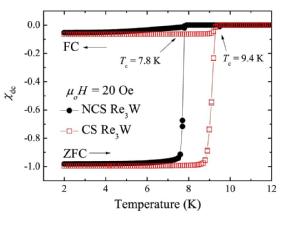 |
| Magnetic susceptibility versus temperature for the noncentrosymmetric and the centrosymmetric Re3W measured in zero-field-cooled and field-cooled mode in an applied magnetic field of 20 Oe. |
We also reported on the superconductivity in the In doped topological crystalline insulator SnTe [29], one of a new class of superconductrs related to Topological Insulators, materials that have topologically protected surface states.
References
[1] H. Kamerlingh Onnes, Leiden Comm. 120b 122b, 124c, (1911).
[2] W. Meissner and R. Ochsenfeld, Naturwissenschaften 21, 787 (1933).
[3] A. A. Abrikosov Sov. Phys JETP 5, 1174 (1957).
[4] J. Bardeen, L. N. Cooper and J. R. Schrieffer, Phys. Rev. 106, 162 (1957); 108, 1175 (1957).
[5] B. D. Josephson Phys. Lett. 1, 251 (1962).
[6] G. Bednorz and K. A. Müller, Z. Phys. B 64, 189 (1986).
[7] G. R. Stewart Rev. Mod. Phys. 56, 755 (1984) and references therein. For more details of the data shown in the figure see, Realignment of the flux-line lattice by a change of symmetry of superconductivity in UPt3, A. Huxley, P. Rodiere, D. McK. Paul, N. van Dijk, R. Cubitt and J. Flouquet, Nature 406, 160 (2000).
[8] Good introductory textbooks on superconductivity for undergraduates: M. Cyrot and D. Pavuna, Introduction to superconductivity and high-Tc materials (World Scientific, River Edge, N.J, 1992); J.R. Waldram, Superconductivity of metals and cuprates (Institute of Physics Publishing, Bristol, 1996); G. Burns, High-temperature superconductivity : an introduction (Academic Press, London,1992); C. P. Poole, H. A. Farach and R. J. Creswick, Superconductivity (Academic Press, San Diego, London, 1995).
Graduate level textbooks: D. R. Tilley and J. Tilley, Superfluidity and Superconductivity, (IOP Publishing, Bristol, 1996), 3rd ed.; Michael Tinkham, Introduction to superconductivity, (London McGraw-Hill, New York, 1975).
[9] There are many websites with useful information on superconductors including www.superconductors.org/ and a site at Oak Ridge National Lab in the USA.
[10] Reconstruction from Small-Angle Neutron Scattering Measurements of the Real Space, Magnetic Field Distribution in the Mixed State of Sr2RuO4, P. G. Kealey, T. M. Riseman, E. M. Forgan, L. M. Galvin, A. P. Mackenzie, S. L. Lee, D. McK. Paul, R. Cubitt, D. F. Agterberg, R. Heeb, Z. Q. Mao and Y. Maeno, Phys. Rev. Lett. 84, 6094 (2000).
[11] R. Nagarajan et al. Phys. Rev. Lett. 72, 274 (1994); R. J. Cava et al. Nature (London) 367, 252 (1994).
[12] Magnetic-Ordering in GdBa2Cu3O6.14, H. A. Mook, D. McK. Paul, B. C. Sales, L. A. Boatner, L. Cussen, Physical Review B 38, 12008 (1988); Magnetic-Ordering in the High-Temperature Superconductor ErBa2Cu3O7-d, D. McK. Paul, H. A. Mook, A. W. Hewat, B. C. Sales, L. A. Boatner, J. O. Ramey, and L. Cussen, Phys. Rev. B 39, 4291 (1989).
[13] Vibrational Anomalies In The Superconducting Compound La1.85 Ba0.15CuO4, G. Balakrishnan, N. R. Bernhoeft, Z. A. Bowden, D. McK. Paul, A. D. Taylor, Nature 327, 45 (1987); Anomalous Structural Behavior Of The Superconducting Compound La1.85Ba0.15CuO4, D. McK. Paul, G. Balakrishnan, N. R. Bernhoeft, W. I. F. David, and W. T. A. Harrison, Phys. Rev. Lett. 58, 1976 (1987).
[14] Observation by Neutron-Diffraction of the Magnetic-Flux Lattice in Single-Crystal YBa2Cu3O7-d, E. M. Forgan, D. McK. Paul, H. A. Mook, P. A. Timmins, H. Keller, S. Sutton, J. S. Abell, Nature 343, 735 (1990); Small-Angle Neutron-Scattering Study of Flux Line Lattices in Twinned YBa2Cu3O7, M. Yethiraj, H. A. Mook, G. D. Wignall, R. Cubitt, E. M. Forgan, D. McK. Paul, and T. Armstrong, Phys. Rev. Lett. 70, 857 (1993); Anisotropic Vortex Lattice in YBa2Cu3O7, M. Yethiraj, H. A. Mook, G. D. Wignall, R. Cubitt, E. M. Forgan, S. L. Lee, D. McK. Paul, and T. Armstrong, Phys. Rev. Lett. 71, 3019 (1993).
[15] Direct Observation of Magnetic-Flux Lattice Melting and Decomposition in the High-Tc Superconductor Bi2.15Sr1.95CaCu2 O8+x, R. Cubitt, E. M. Forgan, G. Yang, S. L. Lee, D. McK. Paul, H. A. Mook, M. Yethiraj, P. H. Kes, T. W. Li, A. A. Menovsky, Z. Tarnawski, and K. Mortensen, Nature 365, 407 (1993).
[16] Single-Crystal Growth of Bi2Sr2CaCu2O8 Using an Infrared Image Furnace, G. Balakrishnan, D. Mc K. Paul, M. R. Lees, and A. T. Boothroyd, Physica C 206, 148 (1993); Superconducting Properties of Doped and Off-Stoichiometric Bi2Sr2CaCu2O8 Single-Crystals, G. Balakrishnan, D. McK. Paul, and M. R. Lees, Physica B 194, 2197 (1994).
[17] Magnetic structure of TmNi2B2C, L. J. Chang, C. V. Tomy, D. McK. Paul, and C. Ritter, Phys. Rev. B 54 , 9031(1996); Anisotropic magnetic properties of TbNi2B2C single crystals, C. V. Tomy et al., Physical Review B 53, 307(1996); Superconductivity and Magnetism in DyNi2B2C Single-Crystals, C. V. Tomy, M. R. Lees, L. Afalfiz, G. Balakrishnan, and D. McK. Paul, Phys. Rev. .B 52, 9186 (1995).
[18] Interaction between magnetic order and the vortex lattice in HoNi2B2C, C. D. Dewhurst, R. A. Doyle, E. Zeldov, and D. McK. Paul, Phys. Rev. Lett. 82, 827 (1999).
[19] First-Order Reorientation Transition of the Flux-Line Lattice in CaAlSi, P. K. Biswas, M. R. Lees, G. Balakrishnan, D. Q. Liao, D. S. Keeble, J. L. Gavilano, N. Egetenmeyer, C. D. Dewhurst, and D. M. Paul, Phys. Rev. Lett. 108, 077001 (2012).
[20] Two-gap superconductivity in Lu2Fe3Si5: A transverse-field muon spin rotation study, P. K. Biswas, G. Balakrishnan, D. M. Paul, C.V. Tomy, M. R. Lees, and A. D. Hillier, Phys. Rev. B 83, 054517 (2011).
[21] Detection of Time-Reversal Symmetry Breaking in the Noncentrosymmetric Superconductor Re6Zr Using Muon-Spin Spectroscopy, R. P. Singh, A. D. Hillier, B. Mazidian, J. Quintanilla, J. F. Annett, D. M. Paul, G. Balakrishnan, M. R. Lees, Phys. Rev. Lett. 112, 107002 (2014).
[22] Evidence for superconductivity with broken time-reversal symmetry in locally noncentrosymmetric SrPtAs, P. K. Biswas, H. Luetkens, T. Neupert, T. Sturzer, C. Baines, G. Pascua, A. P. Schnyder, M. H. Fischer, J. Goryo, M. R. Lees, H. Maeter, F. Bruckner, H.-H. Klauss, M. Nicklas, P. J. Baker, A. D. Hillier, M. Sigrist, A. Amato, and D. Johrendt, Phys. Rev. B 87, 180503(R) (2013).
[24] Structure and superconductivity in two different phases of Re3W, P. K. Biswas, M. R. Lees, A. D. Hillier, R. I. Smith, W. G. Marshall, and D. McK. Paul, Phys. Rev. B 84, 184529 (2011).
[25] Comparative study of the centrosymmetric and noncentrosymmetric superconducting phases of Re3W using muon spin spectroscopy and heat capacity measurements, P. K. Biswas, A. D. Hillier, M. R. Lees, and D. M. Paul, Phys. Rev. B 85, 134505 (2012).
[26] Investigations of the superconducting states of noncentrosymmetric LaPdSi3 and LaPtSi3, M. Smidman, A. D. Hillier, D. T. Adroja, M. R. Lees, V. K. Anand, R. P. Singh, R. I. Smith, D. M. Paul, and G. Balakrishnan, Phys. Rev. B 89, 094509 (2014).
[27] Crystal growth of the non-centrosymmetric superconductor Nb0.18Re0.82, R. P. Singh, M. Smidman, M. R. Lees, D. M. Paul, G. Balakrishnan, J. Cryst. Growth 361, 129 (2012).
[28] Crystal growth and properties of the non-centrosymmetric superconductor, Ru7B3, R. P. Singh, N. A. Parzyk, M. R. Lees, D. M. Paul, G. Balakrishnan, J. Cryst. Growth 395, 22 (2014).
[29] Superconducting properties of the In-substituted topological crystalline insulator SnTe, G. Balakrishnan, L. Bawden, S. Cavendish, M. R. Lees, Phys. Rev. B 87, 140507 (2013).
Nobel Prize in Physics: 1913
"for his investigations on the properties of matter at low temperatures which led, inter alia, to the production of liquid helium"
Nobel Prize in Physics: 1972
"for their jointly developed theory of superconductivity, usually called the BCS-theory"
John Bardeen, Leon Neil Cooper and John Robert Schrieffer
Royal Institute Video
Levitating Superconductor on a Möbius strip
Nobel Prize in Physics: 1973
"for their experimental discoveries regarding tunneling phenomena in semiconductors and superconductors, respectively"
Leo Esaki, Ivar Giaever and Brian David Josephson
Nobel Prize in Physics: 1987
"for their important break-through in the discovery of superconductivity in ceramic materials"
J. Georg Bednorz and K. Alexander Müller
Nobel Prize in Physics: 2003
"for pioneering contributions to the theory of superconductors and superfluids"
A.A. Abrikosov, V.L. Ginzburg, A.J. Leggett
100 Years of Superconductivity
Physics World: 100 Years of Superconductivity - Published in 2011- an issue of Physics World celebrating the 100th anniversary of the discovery of superconductivity.
The Physics of Superconductors
Read more about the physics of superconductors at www.superconductors.org/

